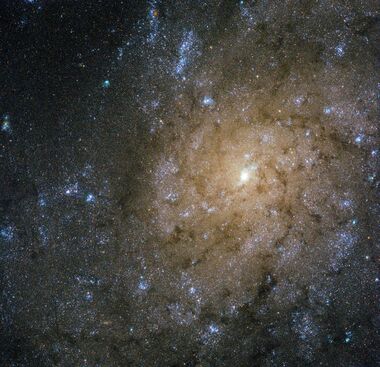Astronomy:NGC 7793
| NGC 7793 | |
|---|---|
 Hubble Space Telescope image of the small bulge and spiral arms of NGC 7793 | |
| Observation data (J2000 epoch) | |
| Constellation | Sculptor |
| Right ascension | 23h 57m 49.753s[1] |
| Declination | −32° 35′ 27.71″[1] |
| Helio radial velocity | 227 km/s[2] |
| Distance | 12.2 Mly (3.7 Mpc)[3] |
| Group or cluster | Sculptor Group[4] |
| Apparent magnitude (V) | 10.0[5] |
| Characteristics | |
| Type | SA(s)d[6] |
| Mass | Stellar: 3.2×109 M☉ |
| Apparent size (V) | 9.3′ × 6.3′[5] (~30kly in diameter) |
| Other designations | |
| NGC 7793, PGC 73049[7] | |
NGC 7793 is a flocculent spiral galaxy in the southern constellation of Sculptor. It was discovered in 1826 by Scottish astronomer James Dunlop.[8] The galaxy is located at a distance of 12.2[3] million light years and is receding with a heliocentric radial velocity of 227 km/s.[2] NGC 7793 is one of the five brightest galaxies within the Sculptor Group.[5][4]
The morphological class of NGC 7793 is SA(s)d,[6] indicating it is unbarred spiral galaxy (SA) with no inner ring structure (s) and the arms are loosely wound and disorganized (d). It is flocculent in appearance with a very small bulge and a star cluster at the nucleus.[5] The galactic disk is inclined at an angle of 53.7° to the line of sight from the Earth. The visible profile is elliptical in form with an angular size of 9.3′ × 6.3′[5] and a major axis aligned along a position angle of 99.3°.[6] There are two nearby dwarf galaxy companions.[9]
On March 25, 2008, a type II-P supernova designated SN 2008bk was discovered in NGC 7793.[10][6] At apparent magnitude 12.5, it became the 2nd brightest supernova of 2008.[11] The progenitor of this supernova was a red supergiant, observed only 547 days prior to the explosion.
Jets from a black hole named P13 power a large nebula designated S26 in the outer spiral of this galaxy. Recently, the mass of P13 was determined to be less than 15 solar masses, and its companion star is estimated to be around 20 solar masses. The two orbit each other in 64 days.[12] Based on this estimate, P13 is stripping material away from a nearby star about ten times faster than was previously believed to be physically possible. If correct, this observation would show flaws in theories that a black hole's mass and rate of consumption are a fixed relationship.[13][14]
Gallery
See also
References
- ↑ 1.0 1.1 Brown, A. G. A. (August 2018). "Gaia Data Release 2: Summary of the contents and survey properties". Astronomy & Astrophysics 616: A1. doi:10.1051/0004-6361/201833051. Bibcode: 2018A&A...616A...1G. Gaia DR2 record for this source at VizieR.
- ↑ 2.0 2.1 Tully, R. Brent et al. (August 3, 2016). "Cosmicflows-3". The Astronomical Journal 152 (2): 50. doi:10.3847/0004-6256/152/2/50. Bibcode: 2016AJ....152...50T.
- ↑ 3.0 3.1 Lianou, S. et al. (November 2019). "Dust properties and star formation of approximately a thousand local galaxies". Astronomy & Astrophysics 631: 19. doi:10.1051/0004-6361/201834553. A38. Bibcode: 2019A&A...631A..38L.
- ↑ 4.0 4.1 I. D. Karachentsev; E. K. Grebel; M. E. Sharina; A. E. Dolphin et al. (2003). "Distances to nearby galaxies in Sculptor". Astronomy and Astrophysics 404 (1): 93–111. doi:10.1051/0004-6361:20030170. Bibcode: 2003A&A...404...93K.
- ↑ 5.0 5.1 5.2 5.3 5.4 König, Michael; Binnewies, Stefan (2017). The Cambridge Photographic Atlas of Galaxies. Cambridge University Press. p. 68. ISBN 9781108103091. https://books.google.com/books?id=OEszDwAAQBAJ&pg=PA68.
- ↑ 6.0 6.1 6.2 6.3 Crowther, Paul A. (January 2013). "On the association between core-collapse supernovae and H ii regions". Monthly Notices of the Royal Astronomical Society 428 (3): 1927–1943. doi:10.1093/mnras/sts145. Bibcode: 2013MNRAS.428.1927C.
- ↑ "NASA/IPAC Extragalactic Database". Results for NGC 7793. http://nedwww.ipac.caltech.edu/cgi-bin/nph-objsearch?objname=NGC+7793&img_stamp=yes&extend=no.
- ↑ James, Dunlop (1828). "A Catalogue of Nebulae and Clusters of Stars in the Southern Hemisphere observed in New South Wales". Philosophical Transactions of the Royal Society 118: 113–151. doi:10.1098/rstl.1828.0010. Bibcode: 1828RSPT..118..113D. https://zenodo.org/record/1432362.
- ↑ Mondal, Chayan et al. (March 2021). "Tracing Young Star-forming Clumps in the Nearby Flocculent Spiral Galaxy NGC 7793 with UVIT Imaging". The Astrophysical Journal 909 (2): 13. doi:10.3847/1538-4357/abe0b4. 203. Bibcode: 2021ApJ...909..203M.
- ↑ David Bishop. "Supernova 2008bk in NGC 7793". supernovae.net (International Supernovae Network). http://www.supernovae.net/sn2008/#2008bk.
- ↑ David Bishop. "Bright Supernovae - 2008". supernovae.net (International Supernovae Network). http://www.supernovae.net/sn2008/.
- ↑ "Hungry black hole eats faster than thought possible". http://www.icrar.org/home/hungry-black-hole.
- ↑ "Black hole emitting a giant gas bubble 1000 light-years wide". 8 July 2010. http://io9.com/5582028/black-hole-emitting-a-giant-gas-bubble-1000-light+years-wide.
- ↑ Winter, Lisa (October 8, 2014). "Small Black Hole Has Huge Appetite That Defies Theory". http://www.iflscience.com/space/small-black-hole-has-huge-appetite-defies-theory.
External links
 |


